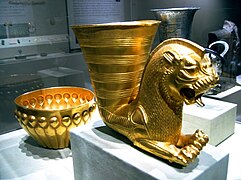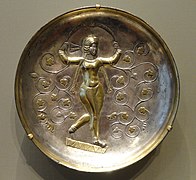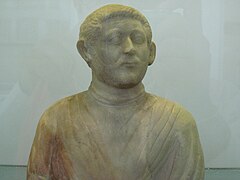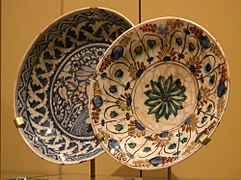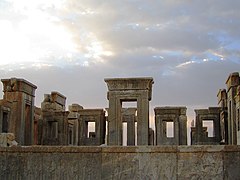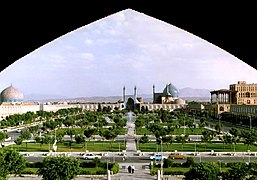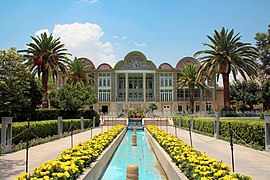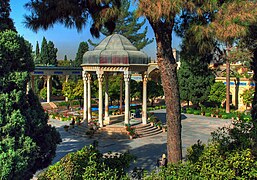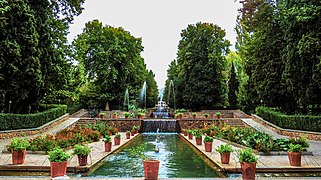Persians
پارسیها/فارسی/ایرانی | |
|---|---|
| Total population | |
| c. 60+ million[1] | |
| Regions with significant populations | |
| 51–65%[2][3][4] (also including Gilaks and Mazanderanis)[2] of the total population | |
| Languages | |
| Persian, other Iranian languages | |
| Religion | |
| Majority: Shia Islam Minority: Zoroastrianism, Christianity, Judaism, Baháʼí Faith, Sunni Islam, and various others[5] | |
| Related ethnic groups | |
| Other Iranian peoples | |
The Persians (/ˈpɜːrʒənz/ PUR-zhənz or /ˈpɜːrʃənz/ PUR-shənz) are an Iranian ethnic group who comprise over half of the population of Iran.[4] They share a common cultural system and are native speakers of the Persian language[6][7][8] as well as of the languages that are closely related to Persian.[9]
The ancient Persians were originally an ancient Iranian people who had migrated to the region of Persis (corresponding to the modern-day Iranian province of Fars) by the 9th century BCE.[10][11] Together with their compatriot allies, they established and ruled some of the world's most powerful empires[12][11] that are well-recognized for their massive cultural, political, and social influence, which covered much of the territory and population of the ancient world.[13][14][15] Throughout history, the Persian people have contributed greatly to art and science.[16][17][18] Persian literature is one of the world's most prominent literary traditions.[19]
In contemporary terminology, people from Afghanistan, Tajikistan, and Uzbekistan who natively speak the Persian language are known as Tajiks, with the former two countries having their own dialects of Persian known as Dari and Tajiki, respectively; whereas those in the Caucasus (primarily in the present-day Republic of Azerbaijan and Dagestan, Russia), albeit heavily assimilated, are known as Tats.[20][21] Historically, however, the terms Tajik and Tat were used synonymously and interchangeably with Persian.[20] Many influential Persian figures hailed from outside of Iran's present-day borders—to the northeast in Afghanistan and Central Asia, and to a lesser extent within the Caucasus proper to the northwest.[22][23] In historical contexts, especially in English, "Persian" may be defined more loosely (often as a national identity) to cover all subjects of the ancient Persian polities, regardless of their ethnic background.
Ethnonym
Etymology
The term Persian, meaning "from Persia", derives from Latin Persia, itself deriving from Greek Persís (Περσίς),[24] a Hellenized form of Old Persian Pārsa (𐎱𐎠𐎼𐎿), which evolves into Fārs (فارس) in modern Persian.[25] In the Bible, particularly in the books of Daniel, Esther, Ezra, and Nehemya, it is given as Pārās (פָּרָס).
A Greek folk etymology connected the name to Perseus, a legendary character in Greek mythology. Herodotus recounts this story,[26] devising a foreign son, Perses, from whom the Persians took the name. Apparently, the Persians themselves knew the story,[27] as Xerxes I tried to use it to suborn the Argives during his invasion of Greece, but ultimately failed to do so.
History of usage
Although Persis (Persia proper) was only one of the provinces of ancient Iran,[28] varieties of this term (e.g., Persia) were adopted through Greek sources and used as an exonym for all of the Persian Empire for many years.[29] Thus, especially in the Western world, the names Persia and Persian came to refer to all of Iran and its subjects.[29][10]
Some medieval and early modern Islamic sources also used cognates of the term Persian to refer to various Iranian peoples and languages, including the speakers of Khwarazmian,[30] Mazanderani,[31] and Old Azeri.[32] 10th-century Iraqi historian Al-Masudi refers to Pahlavi, Dari, and Azari as dialects of the Persian language.[33] In 1333, medieval Moroccan traveler and scholar Ibn Battuta referred to the Afghans of Kabul as a specific sub-tribe of the Persians.[34] Lady Mary (Leonora Woulfe) Sheil, in her observation of Iran during the Qajar era, states that the Kurds and the Leks would consider themselves as belonging to the race of the "old Persians".[35]
On 21 March 1935, the then-king of Iran Reza Shah of the Pahlavi dynasty issued a decree asking the international community to use the term Iran, the native name of the country, in formal correspondence. However, the term Persian is still historically used to designate the predominant population of the Iranian peoples living in the Iranian cultural continent.[36][37]
History
Persia is first attested in Assyrian sources from the third millennium BC in the Old Assyrian form Parahše, designating a region belonging to the Sumerians. The name of this region was adopted by a nomadic ancient Iranian people who migrated to the region in the west and southwest of Lake Urmia, eventually becoming known as "the Persians".[10][38] The ninth-century BC Neo-Assyrian inscription of the Black Obelisk of Shalmaneser III, found at Nimrud, gives it in the Late Assyrian forms Parsua and Parsumaš as a region and a people located in the Zagros Mountains, the latter likely having migrated southward and transferred the name of the region with them to what would become Persis (Persia proper, i.e., modern-day Fars), and that is considered to be the earliest attestation to the ancient Persian people.[39][40][41][42][43]

The ancient Persians played a major role in the downfall of the Neo-Assyrian Empire.[44] The Medes, another group of ancient Iranian people, unified the region under an empire centered in Media, which would become the region's leading cultural and political power of the time by 612 BC.[45] Meanwhile, under the dynasty of the Achaemenids, the Persians formed a vassal state to the central Median power. In 552 BC, the Achaemenid Persians revolted against the Median monarchy, leading to the victory of Cyrus the Great over the throne in 550 BC. The Persians spread their influence to the rest of what is considered to be the Iranian Plateau, and assimilated with the non-Iranian indigenous groups of the region, including the Elamites and the Mannaeans.[46]
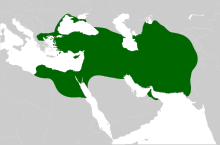
At its greatest extent, the Achaemenid Empire stretched from parts of Eastern Europe in the west to the Indus Valley in the east, making it the largest empire the world had yet seen.[11] The Achaemenids developed the infrastructure to support their growing influence, including the establishment of the cities of Pasargadae and Persepolis.[47] The empire extended as far as the limits of the Greek city states in modern-day mainland Greece, where the Persians and Athenians influenced each other in what is essentially a reciprocal cultural exchange.[48] Its legacy and impact on the kingdom of Macedon was also notably huge,[14] even for centuries after the withdrawal of the Persians from Europe following the Greco-Persian Wars.[14]

During the Achaemenid era, Persian colonists settled in Asia Minor.[49] In Lydia (the most important Achaemenid satrapy), near Sardis, there was the Hyrcanian plain, which, according to Strabo, got its name from the Persian settlers that were moved from Hyrcania.[50] Similarly near Sardis, there was the plain of Cyrus, which further signified the presence of numerous Persian settlements in the area.[51] In all these centuries, Lydia and Pontus were reportedly the chief centers for the worship of the Persian gods in Asia Minor.[51] According to Pausanias, as late as the second century AD, one could witness rituals which resembled the Persian fire ceremony at the towns of Hyrocaesareia and Hypaepa.[51] Mithridates III of Cius, a Persian nobleman and part of the Persian ruling elite of the town of Cius, founded the Kingdom of Pontus in his later life, in northern Asia Minor.[52][53] At the peak of its power, under the infamous Mithridates VI the Great, the Kingdom of Pontus also controlled Colchis, Cappadocia, Bithynia, the Greek colonies of the Tauric Chersonesos, and for a brief time the Roman province of Asia. After a long struggle with Rome in the Mithridatic Wars, Pontus was defeated; part of it was incorporated into the Roman Republic as the province of Bithynia and Pontus, and the eastern half survived as a client kingdom.
Following the Macedonian conquests, the Persian colonists in Cappadocia and the rest of Asia Minor were cut off from their co-religionists in Iran proper, but they continued to practice the Iranian faith of their forefathers.[54] Strabo, who observed them in the Cappadocian Kingdom in the first century BC, records (XV.3.15) that these "fire kindlers" possessed many "holy places of the Persian Gods", as well as fire temples.[54] Strabo, who wrote during the time of Augustus (r. 27 BC – AD 14), almost three hundred years after the fall of the Achaemenid Persian Empire, records only traces of Persians in western Asia Minor; however, he considered Cappadocia "almost a living part of Persia".[55]
The Iranian dominance collapsed in 330 BC following the conquest of the Achaemenid Empire by Alexander the Great, but reemerged shortly after through the establishment of the Parthian Empire in 247 BC, which was founded by a group of ancient Iranian people rising from Parthia. Until the Parthian era, Iranian identity had an ethnic, linguistic, and religious value. However, it did not yet have a political import.[56] The Parthian language, which was used as an official language of the Parthian Empire, left influences on Persian,[57][58][59] as well as on the neighboring Armenian language.

The Parthian monarchy was succeeded by the Persian dynasty of the Sasanians in 224 AD. By the time of the Sasanian Empire, a national culture that was fully aware of being Iranian took shape, partially motivated by restoration and revival of the wisdom of "the old sages" (dānāgān pēšēnīgān).[56] Other aspects of this national culture included the glorification of a great heroic past and an archaizing spirit.[56] Throughout the period, Iranian identity reached its height in every aspect.[56] Middle Persian, which is the immediate ancestor of Modern Persian and a variety of other Iranian dialects,[57][60][61][62] became the official language of the empire[63] and was greatly diffused among Iranians.[56]
The Parthians and the Sasanians would also extensively interact with the Romans culturally. The Roman–Persian wars and the Byzantine–Sasanian wars would shape the landscape of Western Asia, Europe, the Caucasus, North Africa, and the Mediterranean Basin for centuries. For a period of over 400 years, the Sasanians and the neighboring Byzantines were recognized as the two leading powers in the world.[64][65][66] Cappadocia in Late Antiquity, now well into the Roman era, still retained a significant Iranian character; Stephen Mitchell notes in the Oxford Dictionary of Late Antiquity: "Many inhabitants of Cappadocia were of Persian descent and Iranian fire worship is attested as late as 465".[67]
Following the Arab conquest of the Sasanian Empire in the medieval times, the Arab caliphates established their rule over the region for the next several centuries, during which the long process of the Islamization of Iran took place. Confronting the cultural and linguistic dominance of the Persians, beginning by the Umayyad Caliphate, the Arab conquerors began to establish Arabic as the primary language of the subject peoples throughout their empire, sometimes by force, further confirming the new political reality over the region.[68] The Arabic term ʿAjam, denoting "people unable to speak properly", was adopted as a designation for non-Arabs (or non-Arabic speakers), especially the Persians.[69] Although the term had developed a derogatory meaning and implied cultural and ethnic inferiority, it was gradually accepted as a synonym for "Persian"[68][70][71] and still remains today as a designation for the Persian-speaking communities native to the modern Arab states of the Middle East.[72] A series of Muslim Iranian kingdoms were later established on the fringes of the declining Abbasid Caliphate, including that of the ninth-century Samanids, under the reign of whom the Persian language was used officially for the first time after two centuries of no attestation of the language,[73] now having received the Arabic script and a large Arabic vocabulary.[74] Persian language and culture continued to prevail after the invasions and conquests by the Mongols and the Turks (including the Ilkhanate, Ghaznavids, Seljuks, Khwarazmians, and Timurids), who were themselves significantly Persianized, further developing in Asia Minor, Central Asia, and South Asia, where Persian culture flourished by the expansion of the Persianate societies, particularly those of Turco-Persian and Indo-Persian blends.

After over eight centuries of foreign rule within the region, the Iranian hegemony was reestablished by the emergence of the Safavid Empire in the 16th century.[76] Under the Safavid Empire, focus on Persian language and identity was further revived, and the political evolution of the empire once again maintained Persian as the main language of the country.[77] During the times of the Safavids and subsequent modern Iranian dynasties such as the Qajars, architectural and iconographic elements from the time of the Sasanian Persian Empire were reincorporated, linking the modern country with its ancient past.[78] Contemporary embracement of the legacy of Iran's ancient empires, with an emphasis on the Achaemenid Persian Empire, developed particularly under the reign of the Pahlavi dynasty, providing the motive of a modern nationalistic pride.[79] Iran's modern architecture was then inspired by that of the country's classical eras, particularly with the adoption of details from the ancient monuments in the Achaemenid capitals Persepolis and Pasargadae and the Sasanian capital Ctesiphon.[80] Fars, corresponding to the ancient province of Persia, with its modern capital Shiraz, became a center of interest, particularly during the annual international Shiraz Arts Festival and the 2,500th anniversary of the founding of the Persian Empire.[81] The Pahlavi rulers modernized Iran, and ruled it until the 1979 Revolution.
Anthropology
In modern Iran, the Persians make up the majority of the population.[4] They are native speakers of the modern dialects of Persian,[82] which serves as the country's official language.[83]
Persian language

The Persian language belongs to the western group of the Iranian branch of the Indo-European language family. Modern Persian is classified as a continuation of Middle Persian, the official religious and literary language of the Sasanian Empire, itself a continuation of Old Persian, which was used by the time of the Achaemenid Empire.[61][57][60] Old Persian is one of the oldest Indo-European languages attested in original text.[60] Samples of Old Persian have been discovered in present-day Iran, Armenia, Egypt, Iraq, Romania (Gherla),[84][85] and Turkey.[86] The oldest attested text written in Old Persian is from the Behistun Inscription,[87] a multilingual inscription from the time of Achaemenid ruler Darius the Great carved on a cliff in western Iran.
Related groups
There are several ethnic groups and communities that are either ethnically or linguistically related to the Persian people, living predominantly in Iran, and also within Afghanistan, Tajikistan, Uzbekistan, the Caucasus, Turkey, Iraq, and the Arab states of the Persian Gulf.[88]
The Tajiks are a people native to Tajikistan, Afghanistan, and Uzbekistan who speak Persian in a variety of dialects.[20] The Tajiks of Tajikistan and Uzbekistan are native speakers of Tajik, which is the official language of Tajikistan, and those in Afghanistan speak Dari, one of the two official languages of Afghanistan.
The Tat people, an Iranian people native to the Caucasus (primarily living in the Republic of Azerbaijan and the Russian republic of Dagestan), speak a language (Tat language) that is closely related to Persian.[89] The origin of the Tat people is traced to an Iranian-speaking population that was resettled in the Caucasus by the time of the Sasanian Empire.[90][91][92][93][94][95][96]
The Lurs, an ethnic Iranian people native to western Iran, are often associated with the Persians and the Kurds.[97] They speak various dialects of the Luri language, which is considered to be a descendant of Middle Persian.[98][99][62]
The Hazaras, making up the third largest ethnic group in Afghanistan,[100][101][102] speak a variety of Persian by the name of Hazaragi,[103] which is more precisely a part of the Dari dialect continuum.[104][105] The Aimaqs, a semi-nomadic people native to Afghanistan,[106] speak a variety of Persian by the name of Aimaqi, which also belongs to the Dari dialect continuum.[82][107]
Persian-speaking communities native to modern Arab countries are generally designated as Ajam,[72] including the Ajam of Bahrain, the Ajam of Iraq, and the Ajam of Kuwait.
The Parsis are a Zoroastrian community of Persian descent who migrated to South Asia, to escape religious persecution after the fall of the Sassanian Empire.[108] They have had a significant role in the development of India, Pakistan and Sri Lanka, and also played a role in the development of Iranian nationalism during the late Qajar years and Pahlavi dynasty.[109] They are primarily located in the western regions of India principally the states of Gujarat and Maharashtra, with smaller communities in other parts of India and in South and Southeast Asia.[110] They speak a dialect version of Gujarati, and no longer speak in Persian.[111] They do however continue to use Avestan as their liturgical language.[111] The Parsis have adapted many practices and tendencies of the Indian groups that surrounded them, such as Indian dress norms, and the observance of many Indian festivals and ceremonies.[111]
Culture
From Persis and throughout the Median, Achaemenid, Parthian, and Sasanian empires of ancient Iran to the neighboring Greek city states and the kingdom of Macedon,[112][14] and later throughout the medieval Islamic world,[113][17] all the way to modern Iran and others parts of Eurasia, Persian culture has been extended, celebrated, and incorporated.[114][18][113][115] This is due mainly to its geopolitical conditions, and its intricate relationship with the ever-changing political arena once as dominant as the Achaemenid Empire.
The artistic heritage of the Persians is eclectic and has included contributions from both the east and the west. Due to the central location of Iran, Persian art has served as a fusion point between eastern and western traditions. Persians have contributed to various forms of art, including calligraphy, carpet weaving, glasswork, lacquerware, marquetry (khatam), metalwork, miniature illustration, mosaic, pottery, and textile design.[16]
-
Ancient Iranian goddess Anahita depicted on a Sasanian silver vessel. Cleveland Museum of Art, Cleveland.
Literature
The Persian language is known to have one of the world's oldest and most influential literatures.[19] Old Persian written works are attested on several inscriptions from between the 6th and the 4th centuries BC, and Middle Persian literature is attested on inscriptions from the Parthian and Sasanian eras and in Zoroastrian and Manichaean scriptures from between the 3rd to the 10th century AD. New Persian literature flourished after the Arab conquest of Iran with its earliest records from the 9th century,[116] and was developed as a court tradition in many eastern courts.[19] The Shahnameh of Ferdowsi, the works of Rumi, the Rubaiyat of Omar Khayyam, the Panj Ganj of Nizami Ganjavi, the Divān of Hafez, The Conference of the Birds by Attar of Nishapur, and the miscellanea of Gulistan and Bustan by Saadi Shirazi are among the famous works of medieval Persian literature. A thriving contemporary Persian literature has also been formed by the works of writers such as Ahmad Shamlou, Forough Farrokhzad, Mehdi Akhavan-Sales, Parvin E'tesami, Sadegh Hedayat, and Simin Daneshvar, among others.
Not all Persian literature is written in Persian, as works written by Persians in other languages—such as Arabic and Greek—might also be included. At the same time, not all literature written in Persian is written by ethnic Persians or Iranians, as Turkic, Caucasian, and Indic authors have also used Persian literature in the environment of Persianate cultures.
Architecture
The most notable examples of ancient Persian architecture are the works of the Achaemenids hailing from Persis. Achaemenid architecture, dating from the expansion of the empire around 550 BC, flourished in a period of artistic growth that left a legacy ranging from Cyrus the Great's solemn tomb at Pasargadae to the structures at Persepolis and Naqsh-e Rostam.[117] The Bam Citadel, a massive structure at 1,940,000 square feet (180,000 m2) constructed on the Silk Road in Bam, is from around the 5th century BC.[118] The quintessential feature of Achaemenid architecture was its eclectic nature, with elements from Median architecture, Assyrian architecture, and Asiatic Greek architecture all incorporated.[119]
The architectural heritage of the Sasanian Empire includes, among others, castle fortifications such as the Fortifications of Derbent (located in North Caucasus, now part of Russia), the Rudkhan Castle and the Shapur-Khwast Castle, palaces such as the Palace of Ardashir and the Sarvestan Palace, bridges such as the Shahrestan Bridge and the Shapuri Bridge, the Archway of Ctesiphon, and the reliefs at Taq-e Bostan.
-
Ruins of the Tachara, Persepolis.
-
The Sasanian reliefs at Taq-e Bostan.
Architectural elements from the time of Iran's ancient Persian empires have been adopted and incorporated in later period.[78] They were used especially during the modernization of Iran under the reign of the Pahlavi dynasty to contribute to the characterization of the modern country with its ancient history.[79][80]
Gardens
Xenophon, in his Oeconomicus,[120] states:
"The Great King [Cyrus II]...in all the districts he resides in and visits, takes care that there are parádeisos ("paradise") as they [Persians] call them, full of the good and beautiful things that the soil produce."
The Persian garden, the earliest examples of which were found throughout the Achaemenid Empire, has an integral position in Persian architecture.[121] Gardens assumed an important place for the Achaemenid monarchs,[120] and utilized the advanced Achaemenid knowledge of water technologies,[122] including aqueducts, earliest recorded gravity-fed water rills, and basins arranged in a geometric system. The enclosure of this symmetrically arranged planting and irrigation by an infrastructure such as a palace created the impression of "paradise".[123] The word paradise itself originates from Avestan pairidaēza (Old Persian paridaida; New Persian pardis, ferdows), which literally translates to "walled-around". Characterized by its quadripartite (čārbāq) design, the Persian garden was evolved and developed into various forms throughout history,[120] and was also adopted in various other cultures in Eurasia. It was inscribed on UNESCO's World Heritage List in June 2011.
Carpets

Carpet weaving is an essential part of the Persian culture,[124] and Persian rugs are said to be one of the most detailed hand-made works of art.
Achaemenid rug and carpet artistry is well recognized. Xenophon describes the carpet production in the city of Sardis, stating that the locals take pride in their carpet production. A special mention of Persian carpets is also made by Athenaeus of Naucratis in his Deipnosophistae, as he describes a "delightfully embroidered" Persian carpet with "preposterous shapes of griffins".[125]
The Pazyryk carpet, a Scythian pile-carpet dating back to the 4th century BC that is regarded as the world's oldest existing carpet, depicts elements of Assyrian and Achaemenid designs, including stylistic references to the stone slab designs found in Persian royal buildings.[125]
Music

According to the accounts reported by Xenophon, a great number of singers were present at the Achaemenid court. However, little information is available from the music of that era. The music scene of the Sasanian Empire has a more available and detailed documentation than the earlier periods, and is especially more evident within the context of Zoroastrian musical rituals.[126] Overall, Sasanian music was influential and was adopted in the subsequent eras.[127]
Iranian music, as a whole, utilizes a variety of musical instruments that are unique to the region, and has remarkably evolved since the ancient and medieval times. In traditional Sasanian music, the octave was divided into seventeen tones. By the end of the 13th century, Iranian music also maintained a twelve-interval octave, which resembled the western counterparts.[128]
Observances
The Iranian New Year's Day, Nowruz, which translates to "new day", is celebrated by Persians and other peoples of Iran to mark the beginning of spring on the vernal equinox on the first day of Farvardin, the first month of the Iranian calendar, which corresponds to around March 21 in the Gregorian calendar. An ancient tradition that has been preserved in Iran and several other countries that were under the influence of the ancient empires of Iran,[129][130] Nowruz has been registered on UNESCO's Intangible Cultural Heritage Lists.[131] In Iran, the Nowruz celebrations (incl. Charshanbe Suri and Sizdebedar) begin on the eve of the last Wednesday of the preceding year in the Iranian calendar and last on the 13th day of the new year. Islamic festivals are also widely celebrated by Muslim Persians.
See also
References
- ^ "Persian, Iranian". Ethnologue. Retrieved 11 December 2018. Total Iranian Persian users in all countries.
- ^ a b Elling, Rasmus Christian (18 February 2013). Minorities in Iran: Nationalism and Ethnicity after Khomeini. Springer. p. 19. ISBN 978-1-137-04780-9.
The Factbook puts 'Persian and Persian dialects' at 58 percent, but 51 percent of the population as ethnic Persians, while the Library of Congress states that Persian 'is spoken as a mother tongue by at least 65 percent of the population and as a second language by a large proportion of the remaining 35 percent. The 'Persian' mentioned in the latter report must thus also include Gilaki and Mazi. However, Gilaki and Mazi are actually from a different branch of the Iranian language subfamily than Persian, and could be as such be seen not as dialects, but as distinct languages. Suffice it here to say that while some scholars see categories such as Gilakis and Mazandaranis as referring to separate ethnic groups due to their linguistic traits, others count them as 'Persians' on exactly the same basis.
- ^ Crane, Keith; Lal, Rollie; Martini, Jeffrey (6 June 2008). Iran's Political, Demographic, and Economic Vulnerabilities. RAND Corporation. p. 38. ISBN 9780833045270. Retrieved 17 January 2023.
- ^ a b c "Country Profile: Iran" (PDF). Library of Congress – Federal Research Division. May 2008. Archived from the original (PDF) on 2015-10-07. Retrieved 30 April 2019.
- ^ "Goman Poll".
- ^ Beck, Lois (2014). Nomads in Postrevolutionary Iran: The Qashqa'i in an Era of Change. Routledge. p. xxii. ISBN 978-1317743866.
(...) an ethnic Persian; adheres to cultural systems connected with other ethnic Persians (...)
- ^ Samadi, Habibeh; Perkins, Nick (2012). Ball, Martin; Crystal, David; Fletcher, Paul (eds.). Assessing Grammar: The Languages of Lars. Multilingual Matters. p. 169. ISBN 978-1-84769-637-3.
- ^ Fyre, R. N. (29 March 2012). "IRAN v. PEOPLES OF IRAN". Encyclopædia Iranica.
The largest group of people in present-day Iran are Persians (*q.v.) who speak dialects of the language called Fārsi in Persian, since it was primarily the tongue of the people of Fārs."
- ^ Anonby, Erik J. (20 December 2012). "LORI LANGUAGE ii. Sociolinguistic Status of Lori". Encyclopædia Iranica.
Conversely, the Nehāvand sub-province of Hamadān is home to ethnic Persians who speak NLori as a mother tongue. (...) The same is true of areas to the southwest, south, and east of the Lori language area (...): while the varieties spoken there show more structural similarity to Lori than to Persian, speakers identify themselves as ethnically Persian.
- ^ a b c Xavier de Planhol (24 January 2012). "FĀRS i. Geography". Encyclopædia Iranica. Vol. IX. pp. ?–336.
The name of Fārs is undoubtedly attested in Assyrian sources since the third millennium B.C.E. under the form Parahše. Originally, it was the "land of horses" of the Sumerians (Herzfeld, pp. 181–82, 184–86). The name was adopted by Iranian tribes which established themselves there in the 9th century B.C.E. in the west and southwest of Urmia lake. The Parsua (Pārsa) are mentioned there for the first time in 843 B.C.E., during the reign of Salmanassar III, and then, after they migrated to the southeast (Boehmer, pp. 193–97), the name was transferred, between 690 and 640, to a region previously called Anšan (q.v.) in Elamite sources (Herzfeld, pp. 169–71, 178–79, 186). From that moment the name acquired the connotation of an ethnic region, the land of the Persians, and the Persians soon thereafter founded the vast Achaemenid empire. A never-ending confusion thus set in between a narrow, limited, geographical usage of the term—Persia in the sense of the land where the aforesaid Persian tribes had shaped the core of their power—and a broader, more general usage of the term to designate the much larger area affected by the political and cultural radiance of the Achaemenids. The confusion between the two senses of the word was continuous, fueled by the Greeks who used the name Persai to designate the entire empire.
- ^ a b c Sacks, David; Murray, Oswyn; Brody, Lisa R. (2005). Encyclopedia of the Ancient Greek World. Facts On File. p. 256 (at the right portion of the page). ISBN 978-0-8160-5722-1.
- ^ Schmitt, R. "ACHAEMENID DYNASTY". Encyclopædia Iranica. Vol. I. pp. 414–426.
In 550 B.C. Cyrus (called "the Great" by the Greeks) overthrew the Median empire under Astyages and brought the Persians into domination over the Iranian peoples; he achieved combined rule over all Iran as the first real monarch of the Achaemenid dynasty. Within a few years he founded a multinational empire without precedent—a first world-empire of historical importance, since it embraced all previous civilized states of the ancient Near East. (...) The Persian empire was a multinational state under the leadership of the Persians; among these peoples the Medes, Iranian sister nation of the Persians, held a special position.
- ^ Farr, Edward (1850). History of the Persians. Robert Carter. pp. 124–7.
- ^ a b c d Roisman & Worthington 2011, p. 345.
- ^ Durant, Will (1950). Age of Faith. Simon and Schuster. p. 150.
Repaying its debt, Sasanian art exported its forms and motives eastward into India, Turkestan, and China, westward into Syria, Asia Minor, Constantinople, the Balkans, Egypt, and Spain.
- ^ a b Burke, Andrew; Elliot, Mark (2008). Iran. Lonely Planet. pp. 295 & 114–5 (for architecture) and pp. 68–72 (for arts). ISBN 9781742203492.
- ^ a b Hovannisian, Richard G.; Sabagh, Georges (1998). The Persian Presence in the Islamic World. Cambridge University Press. pp. 80–83. ISBN 9780521591850.
- ^ a b Spuler, Bertold; Marcinkowski, M. Ismail (2003). Persian Historiography & Geography. Pustaka Nasional Pte Ltd. ISBN 9789971774882.
- ^ a b c Arberry, Arthur John (1953). The Legacy of Persia. Oxford: Clarendon Press. p. 200. ISBN 0-19-821905-9.
- ^ a b c "TAJIK i. THE ETHNONYM: ORIGINS AND APPLICATION". Encyclopædia Iranica. 20 July 2009.
By mid-Safavid times the usage tājik for 'Persian(s) of Iran' may be considered a literary affectation, an expression of the traditional rivalry between Men of the Sword and Men of the Pen. Pietro della Valle, writing from Isfahan in 1617, cites only Pārsi and ʿAjami as autonyms for the indigenous Persians, and Tāt and raʿiat 'peasant(ry), subject(s)' as pejorative heteronyms used by the Qezelbāš (Qizilbāš) Torkmān elite. Perhaps by about 1400, reference to actual Tajiks was directed mostly at Persian-speakers in Afghanistan and Central Asia; (...)
- ^ Ostler, Nicholas (2010). The Last Lingua Franca: English Until the Return of Babel. Penguin UK. pp. 1–352. ISBN 978-0141922218.
Tat was known to have been used at different times to designate Crimean Goths, Greeks and sedentary peoples generally, but its primary reference came to be the Persians within the Turkic domains. (...) Tat is nowadays specialized to refer to special groups with Iranian languages in the west of the Caspian Sea.
- ^ Nava'i, Ali Shir (tr. & ed. Robert Devereaux) (1996). Muhakamat al-lughatain. Leiden: Brill. p. 6.
- ^ Starr, S. F. (2013). Lost Enlightenment: Central Asia's Golden Age from the Arab Conquest to Tamerlane. Princeton University Press.
- ^ Περσίς. Liddell, Henry George; Scott, Robert; A Greek–English Lexicon at the Perseus Project.
- ^ Harper, Douglas. "Persia". Online Etymology Dictionary.
- ^ Herodotus. "61". Histories. Vol. Book 7.
- ^ Herodotus. "150". Histories. Vol. Book 7.
- ^ Wilson, Arnold (2012). "The Middle Ages: Fars". The Persian Gulf (RLE Iran A). Routledge. p. 71. ISBN 978-1136841057.
- ^ a b Axworthy, Michael (2017). Iran: What Everyone Needs to Know. Oxford University Press. p. 16. ISBN 978-0190232962.
- ^ For example, Al-Biruni, a native speaker of Khwarezmian, refers to "the people of Khwarizm" as "a branch of the Persian tree". See: Al-Biruni (2001). Al-Athar al-Baqiyya 'an al-Qurun al-Khaliyya [The Remaining Signs of Past Centuries]. Tehran: Miras-e Maktub. p. 56.
و أما أهل خوارزم، و إن کانوا غصنا ً من دوحة الفُرس (...)
. (Translation: "The people of Khwarizm, they are a branch of the Persian tree.") - ^ The language used in Marzbān-nāma was, in the words of the 13th-century historian Sa'ad ad-Din Warawini, "the language of Ṭabaristan and old, ancient Persian (fārsī-yi ḳadīm-i bāstān)". See: Kramers, J.H. (2007). "Marzbān-Nāma". In Bearman, P.; Bianqui, Th.; Bosworth, C.E.; van Donzel, E.; Heinrichs, W.P. (eds.). Encyclopaedia of Islam. Brill. Retrieved 18 November 2007.
- ^ 10th-century Arab Muslim writer Ibn Hawqal, in his Ṣūrat al-Arḍ, refers to "the language of the people of Azerbaijan and most of the people of Armenia" as al-fāresīya. Yarshater, E. (18 August 2011). "AZERBAIJAN vii. The Iranian Language of Azerbaijan". Encyclopædia Iranica. Vol. III. pp. 238–245.
- ^ Al Mas'udi (1894). De Goeje, M.J. (ed.). Kitab al-Tanbih wa-l-Ishraf (in Arabic). Brill. pp. 77–78.
- ^ Ibn Battuta (2004). Travels in Asia and Africa, 1325–1354. Routledge. p. 180. ISBN 0-415-34473-5.
We travelled on to Kabul, formerly a vast town, the site of which is now occupied by a village inhabited by a tribe of Persians called Afghans. They hold mountains and defiles and possess considerable strength, and are mostly highwaymen. Their principal mountain is called Kuh Sulayman. It is told that the prophet Sulayman [Solomon] ascended this mountain and having looked out over India, which was then covered with darkness, returned without entering it.
- ^ Sheil, Lady Mary Leonora Woulfe (1856). Glimpses of Life and Manners in Persia. J. Murray. p. 394.
- ^ "Persian". Merriam-Webster. 13 August 2010. Retrieved 10 June 2012.
- ^ Bausani, Alessandro (1971). The Persians, from the Earliest Days to the Twentieth Century. Elek. ISBN 978-0-236-17760-8.
- ^ Stearns, Peter N., ed. (2001). "The Medes and the Persians, c.1500-559". Encyclopedia of World History (6th ed.). The Houghton Mifflin Company.
- ^ Schmitt, R. (21 July 2011). "ACHAEMENID DYNASTY". Encyclopædia Iranica. Vol. I. pp. 414–426.
The Achaemenid clan possibly ruled over the Persian tribes already in the 9th century B.C., when they were still settled in northern Iran near Lake Urmia and tributary to the Assyrians. Of a king with the name Achaemenes there is no historical evidence; but it may have been under him that the Persians, under the pressure of Medes, Assyrians, and Urartians, migrated south into the Zagros region, where they founded, near the Elamite borders, the small state Parsumaš (with residence at present-day Masǰed-e Solaymān in the Baḵtīārī mountains, according to R. Ghirshman).
- ^ Strootman, Rolf; Versluys, M. J. (2017). Persianism in Antiquity. Franz Steiner Verlag. p. 22. ISBN 9783515113823.. (footnote 53).
- ^ Zarinkoob, Abdolhossein. Ruzgārān: Tārix-e Irān az Āğāz ta Soqut-e Saltanat-e Pahlavi روزگاران: تاریخ ایران از آغاز تا سقوط سلطنت پهلوی [Times: History of Iran from the Beginning to the Fall of the Pahlavi Monarchy] (in Persian). Sokhan. p. 37.
- ^ Firuzmandi, Bahman (1996). Mād, Haxāmaneši, Aškāni, Sāsāni ماد، هخامنشی، اشکانی، ساسانی [Median, Achaemenid, Arsacid, Sasanian]. Marlik. pp. 12–20, 155.
- ^ Eduljee, K.E. (2012), "Zoroastrian Heritage", Heritage Institute, retrieved 9 April 2014
- ^ Oppenheim, A. Leo (1964). Ancient Mesopotamia: Portrait of a Dead Civilization. University of Chicago Press. p. 49.
- ^ Yarshater, Ehsan (29 March 2012). "IRAN ii. IRANIAN HISTORY (1) Pre-Islamic Times". Encyclopædia Iranica. Vol. XIII. pp. 212–224.
Of the numerous Iranian tribes who had settled in Iranian plateau, it was the Medes (...) who grew in power and achieved prominence. (...) Finally in 612 B.C.E. and in alliance with the Babylonians, he attacked the Assyrian capital, Nineveh. Their combined forces succeeded in bringing the Assyrian Empire down, thus eliminating a power that had ruled with ruthless efficiency over the Middle East for several centuries. (...) Achaemenes (q.v.; Haxāmaniš), eponymous ancestor of the Achaemenids according to Darius I, formed a kingdom in the Elamite territory of Anshan in Fārs as a vassal of the Median king (...).
- ^ Xavier de Planhol (29 March 2012). "IRAN i. LANDS OF IRAN". Encyclopædia Iranica. Vol. XIII. pp. 204–212.
- ^ Gates, Charles (2003). Ancient Cities: The Archaeology of Urban Life in the Ancient Near East and Egypt, Greece and Rome. Psychology Press. p. 186. ISBN 9780415121828.
- ^ Margaret Christina Miller (2004). Athens and Persia in the Fifth Century BC: A Study in Cultural Receptivity. Cambridge University Press. p. 243. ISBN 9780521607582.
- ^ Raditsa 1983, p. 105.
- ^ Raditsa 1983, pp. 102, 105.
- ^ a b c Raditsa 1983, p. 102.
- ^ McGing 1986, p. 15.
- ^ Van Dam 2002, p. 17.
- ^ a b Boyce 2001, p. 85.
- ^ Raditsa 1983, p. 107.
- ^ a b c d e Gnoli, Gherardo (30 March 2012). "IRANIAN IDENTITY ii. PRE-ISLAMIC PERIOD". Encyclopædia Iranica. Vol. XIII. pp. 504–507.
The inscriptions of Darius I (...) and Xerxes, in which the different provinces of the empire are listed, make it clear that, between the end of the 6th century and the middle of the 5th century B.C.E., the Persians were already aware of belonging to the ariya "Iranian" nation (...). Darius and Xerxes boast of belonging to a stock which they call "Iranian": they proclaim themselves "Iranian" and "of Iranian stock," ariya and ariya čiça respectively, in inscriptions in which the Iranian countries come first in a list that is arranged in a new hierarchical and ethno-geographical order, compared for instance with the list of countries in Darius's inscription at Behistun (...). All this evidence shows that the name arya "Iranian" was a collective definition, denoting peoples (...) who were aware of belonging to the one ethnic stock, speaking a common language, and having a religious tradition that centered on the cult of Ahura Mazdā. (...) Although, up until the end of the Parthian period, Iranian identity had an ethnic, linguistic, and religious value, it did not yet have a political import. The idea of an "Iranian" empire or kingdom is a purely Sasanian one. (...) It was in the Sasanian period, then, that the pre-Islamic Iranian identity reached the height of its fulfilment in every aspect: political, religious, cultural, and linguistic (with the growing diffusion of Middle Persian). Its main ingredients were the appeal to a heroic past that was identified or confused with little-known Achaemenid origins (...), and the religious tradition, for which the Avesta was the chief source.
- ^ a b c Ammon, Ulrich; Dittmar, Norbert; Mattheier, Klaus J.; Trudgill, Peter (2008). Sociolinguistics / Soziolinguistik (2 ed.). Walter de Gruyter. p. 1912. ISBN 978-3110199871.
The Pahlavi language (also known as Middle Persian) was the official language of Iran during the Sassanid dynasty (from 3rd to 7th century A. D.). Pahlavi is the direct continuation of old Persian, and was used as the written official language of the country. However, after the Moslem conquest and the collapse of the Sassanids, Arabic became the dominant language of the country and Pahlavi lost its importance, and was gradually replaced by Dari, a variety of Middle Persian, with considerable loan elements from Arabic and Parthian.
- ^ Windfuhr, G. (1989). "New West Iranian". In Schmitt, R. (ed.). Compendium Linguarum Iranicarum. Wiesbaden. pp. 251–62.
{{cite book}}: CS1 maint: location missing publisher (link) - ^ Asatrian, Garnik S. (28 November 2011). "DIMLĪ". Encyclopædia Iranica. Vol. VI. pp. 405–411.
- ^ a b c Skjærvø, Prods Oktor (29 March 2012). "IRAN vi. IRANIAN LANGUAGES AND SCRIPTS (2) Documentation". Encyclopaedia Iranica. Vol. XIII. pp. 348–366.
Only the official languages Old, Middle, and New Persian represent three stages of one and the same language, whereas close genetic relationships are difficult to establish between other Middle and Modern Iranian languages. Modern Yaḡnōbi belongs to the same dialect group as Sogdian, but is not a direct descendant; Bac-trian may be closely related to modern Yidḡa and Munji (Munjāni); and Wakhi (Wāḵi) belongs with Khotanese. (...) New Persian, the descendant of Middle Persian and official language of Iranian states for centuries, is today spoken widely in and outside Iran in a number of variants.
- ^ a b Lazard, Gilbert (1975). "The Rise of the New Persian Language". In Frye, R. N. (ed.). The Cambridge History of Iran. Vol. 4. Cambridge: Cambridge University Press. pp. 595–632.
The language known as New Persian, which was usually called at this period by the name of darī or parsī-i darī, can be classified linguistically as a continuation of Middle Persian, the official, religious and literary language of Sasanian Iran, itself a continuation of Old Persian, the language of the Achaemenids. Unlike the other languages and dialects, ancient and modern, of the Iranian group such as Avestan, Parthian, Soghdian, Kurdish, Pashto, etc., Old Middle and New Persian represent one and the same language at three states of its history. It had its origin in Fārs (the true Persian country from the historical point of view) and is differentiated by dialectical features, still easily recognizable from the dialects prevailing in north-western and eastern Iran.
- ^ a b Coon, C.S. "Demography and Ethnography". Iran. Encyclopaedia of Islam. Vol. IV. E.J. Brill. pp. 10–8.
The Lurs speak an aberrant form of Archaic Persian (...)
- ^ Fortson, Benjamin W. (2009). Indo-European Language and Culture: An Introduction. John Wiley and Sons. p. 242.
Middle Persian was the official language of the Sassanian dynasty (...)
- ^ (Shapur Shahbazi 2005)
- ^ Stillman, Norman A. (1979). The Jews of Arab Lands. Jewish Publication Society. p. 22. ISBN 0827611552.
- ^ International Congress of Byzantine Studies (30 September 2006). Proceedings of the 21st International Congress of Byzantine Studies, London, 21-26 August 2006. Vol. 1–3. Ashgate Publishing. p. 29. ISBN 075465740X.
- ^ Mitchell 2018, p. 290.
- ^ a b Frye, Richard Nelson; Zarrinkoub, Abdolhosein (1975). Cambridge History of Iran. Vol. 4. London. p. 46.
{{cite book}}: CS1 maint: location missing publisher (link) - ^ "ʿAJAM". Encyclopædia Iranica. Vol. I. 29 July 2011. pp. 700–701.
- ^ Esposito, John L. (21 October 2004). The Oxford Dictionary of Islam. Oxford University Press. p. 12. ISBN 9780199757268.
People unable to speak properly. Refers to non-Arabs. Connotes cultural and ethnic inferiority. Adjectival form: ajami. Principally used to designate (and eventually synonymous with) Persians.
- ^ Ngom, Fallou; Zito, Alex (2012). "Sub-Saharan African literature, ʿAjamī". In Fleet, Kate; Krämer, Gudrun; Matringe, Denis; Nawas, John; Rowson, Everett (eds.). Encyclopaedia of Islam, THREE. doi:10.1163/1573-3912_ei3_COM_26630.
- ^ a b Ende, Werner; Steinbach, Udo (2010). Islam in the World Today: A Handbook of Politics, Religion, Culture, and Society. Cornell University Press. p. 533. ISBN 9780801464898.
- ^ Paul, Ludwig (19 November 2013). "PERSIAN LANGUAGE i. Early New Persian". Encyclopædia Iranica.
- ^ Perry, John R. (10 August 2011). "ARABIC LANGUAGE v. Arabic Elements in Persian". Encyclopædia Iranica. Vol. II. pp. 229–243.
- ^ Masters, Bruce (2009). "Baghdad". In Ágoston, Gábor; Masters, Bruce (eds.). Encyclopedia of the Ottoman Empire. New York: Facts On File. p. 71. ISBN 978-0-8160-6259-1. LCCN 2008020716. Archived from the original on 16 May 2016. Retrieved 21 June 2022.
- ^ Savory, R.M. (1980). Iran under the Safavids. Cambridge: Cambridge University Press. p. 3.
Why is there such confusion about the origins of this important dynasty, which reasserted Iranian identity and established an independent Iranian state after eight and a half centuries of rule by foreign dynasties?
- ^ Matthee, Rudi (28 July 2008). "SAFAVID DYNASTY". Encyclopædia Iranica.
- ^ a b Hillenbrand, R. (11 August 2011). "ARCHITECTURE vi. Safavid to Qajar Periods". Encyclopædia Iranica. Vol. II. pp. 345–349.
Safavid inscriptions on the pre Islamic monuments (e.g., Persepolis and Bīsotūn) perhaps presage that wholesale adoption of and identification with ancient Iran that later characterized the Qajars, but there are not enough inscriptions to clinch the point. (...) An unexpected burst of activity in secular architecture marks the 17th century. Bridges which have wider functions than carrying traffic were built, reviving Sasanian custom (...). (...) Qajar decoration is usually unmistakable. Simple, rather strident tiled geometric or epigraphic designs in small glazed bricks were especially popular. The repertory of cuerda seca tiles now included episodes from the epic and legendary past, portraits of Europeans, scenes from modern life, and the country's heraldic blazon of the lion and the sun (...). Pavilions and palaces bore figural paintings which revived Sasanian royal iconography (Negārestān palace, Tehran) or betrayed the influence of European illustrated magazines or painted postcards depicting landscapes and tourist spots (...).
- ^ a b Amanat, Abbas (22 March 2012). "HISTORIOGRAPHY ix. PAHLAVI PERIOD (1)". Encyclopædia Iranica. Vol. XII. pp. 377–386.
Typical of comparable nationalist historiographies in the early part of the 20th century (e.g., Greek, Italian, Egyptian, and Turkish), the state-sponsored historical narrative under the Pahlavis decidedly favored highlighting the might and glory of the ancient Persian empires, as supported by new archeological and textual evidences. (...) Moreover, promotion of the ancient past as a wholesale propaganda tool in the service of the state engendered nationalistic pride that proved detrimental to dispassionate historical inquiry. (...) The most visible change in the nationalist historiography under Reżā Shah was emphasis on the pre-Islamic, and particularly the Achaemenid, past.
- ^ a b Wilber, D. N. (11 August 2011). "ARCHITECTURE vii. Pahlavi, before World War II". Encyclopædia Iranica. Vol. II. pp. 349–351.
- ^ Ashraf, Ahmad (24 January 2012). "FĀRS iv. History in the Qajar and Pahlavi Periods". Encyclopædia Iranica. Vol. IX. pp. 341–351.
- ^ a b "Subfamily: Farsic". Glottolog. Retrieved 1 May 2019.
- ^ "Iran". University of Cambridge. Archived from the original on 18 September 2012. Retrieved 16 July 2013.
- ^ Kuhrt 2013, p. 197.
- ^ Schmitt 2000, p. 53.
- ^ Kent, R. G. (1950). Old Persian: Grammar Texts Lexicon. American Oriental Society. p. 6.
- ^ (Schmitt 2008, pp. 80–1)
- ^ "SociolinguistEssex X – 2005" (PDF). Essex University. 2005. p. 10. Archived from the original (PDF) on 14 October 2013. Retrieved 29 September 2013.
- ^ Gruenberg, Alexander (1966). "Tatskij jazyk". In Vinogradov, V. V. (ed.). Jazyki narodov SSSR. Vol. 1: Indoevropejskie jazyki. pp. 281–301.
The Tat language belongs to the Southwest group of Iranian languages and is close in its grammatical structure and lexical content to the Persian and Tajik languages.
- ^ Khanam, R., ed. (2005). Encyclopaedic Ethnography of Middle-East and Central Asia. Vol. 1: P-Z. Global Vision Publishing House. p. 746.
The contemporary Tats are the descendants of an Iranian-speaking population sent out of Persia by the dynasty of the Sasanids in the fifth to sixth centuries.
- ^ Windfuhr, Gernot (1979). Persian Grammar: history and state of its study. Walter de Gruyter. p. 4.
(...) Tat- Persian spoken in the East Caucasus (...)
- ^ Dalby, Andrew (2014). Dictionary of Languages: The Definitive Reference to More Than 400 Languages. Bloomsbury Publishing. p. 109. ISBN 978-1408102145.
(...) and Tat (a variety of Persian) (...)
- ^ Windfuhr, Genot (2013). Iranian Languages. Routledge. p. 417. ISBN 978-1135797041.
The Northwestern outpost of Persian is Caucasian Tat Persian (...)
- ^ V. Minorsky, "Tat" in M. Th. Houtsma et al., eds., The Encyclopædia of Islam: A Dictionary of the Geography, Ethnography and Biography of the Muhammadan Peoples, 4 vols. and Suppl., Leiden: Late E.J. Brill and London: Luzac, 1913–38. "Like most Persian dialects, Tati is not very regular in its characteristic features (...)".
- ^ Kerslake, C. (January 2010). "Journal of Islamic Studies". 21 (1). Oxford University Press (published 4 March 2010): 147–151.
It is a comparison of the verbal systems of three varieties of Persian—standard Persian, Tat, and Tajik (...)
{{cite journal}}: Cite journal requires|journal=(help) - ^ Borjian, Habib (2006). "Tabari Language Materials from Il'ya Berezin's Recherches sur les dialectes persans". Iran and the Caucasus. 10 (2). Brill: 243–258. doi:10.1163/157338406780346005.
It embraces Gilani, Ta- lysh, Tabari, Kurdish, Gabri, and the Tati Persian of the Caucasus, all but the last belonging to the north-western group of Iranian language.
- ^ Frye, Richard N. (1983). Handbuch der Altertumswissenschaft, Part 3, Volume 7. Beck. p. 29. ISBN 978-3406093975.
- ^ Stilo, Donald (5 April 2012). "Isfahan xxi. PROVINCIAL DIALECTS". Encyclopædia Iranica. Vol. XIV. pp. 93–112.
- ^ Coon, C.S. "Iran: Demography and Ethnography". Encyclopedia Of Islam. Vol. IV. E.J. Brill. pp. 8–10.
- ^ "Afghanistan — The World Factbook". Central Intelligence Agency. Retrieved 17 July 2015.
- ^ Hyder, Kamal (12 November 2011). "Hazara community finds safe haven in Peshawar". Al Jazeera English. Retrieved 13 November 2011.
- ^ "Country Profile: Afghanistan" (PDF). Library of Congress. August 2008. Retrieved 5 May 2019.
- ^ Kieffer, Charles M. (20 March 2012). "HAZĀRA iv. Hazāragi dialect". Encyclopædia Iranica. Vol. XII. pp. 90–93. Retrieved 5 June 2014.
- ^ Schurmann, Franz (1962). The Mongols of Afghanistan: An Ethnography of the Moghôls and Related Peoples of Afghanistan. The Hague, Netherlands: Mouton. p. 17. OCLC 401634.
- ^ Jamal, Abedin (2010). Attitudes Toward Hazaragi. Theses. p. 217. Retrieved 5 May 2019.
- ^ Janata, A. "AYMĀQ". In Yarshater, Ehsan (ed.). Encyclopædia Iranica (Online ed.). United States: Columbia University.
- ^ "Aimaq". World Culture Encyclopedia. everyculture.com. Retrieved 14 August 2009.
- ^ Marashi, Afshin (2020-06-08). Exile and the Nation: The Parsi Community of India & the Making of Modern Iran. University of Texas Press. ISBN 978-1-4773-2082-2.
- ^ Ringer, Monica M. (2012), Amanat, Abbas; Vejdani, Farzin (eds.), "Iranian Nationalism and Zoroastrian Identity", Iran Facing Others: Identity Boundaries in a Historical Perspective, New York: Palgrave Macmillan US, pp. 267–277, doi:10.1057/9781137013408_13, ISBN 978-1-137-01340-8, retrieved 2023-03-17
- ^ Palsetia, Jesse S. (2001-01-01). The Parsis of India: Preservation of Identity in Bombay City. BRILL. ISBN 978-90-04-12114-0.
- ^ a b c Palsetia, Jesse S. (2001). The Parsis of India: Preservation of Identity in Bombay City. Brill. p. 13.
- ^ Grote, George (1899). Greece: I. Legendary Greece: II. Grecian history to the reign of Peisistratus at Athens. Vol. 12. P. F. Collier. p. 106.
- ^ a b Lapidus, Ira Marvin (2002). A History of Islamic Societies. Cambridge University Press. p. 127. ISBN 9780521779333.
- ^ Sagar, Krishna Chandra (1992). Foreign Influence on Ancient India. Northern Book Centre. p. 17. ISBN 9788172110284.
- ^ Miller, Margaret Christina (2004). Athens and Persia in the Fifth Century BC: A Study in Cultural Receptivity. Cambridge University Press. pp. 243–251. ISBN 9780521607582.
- ^ Skjærvø, Prods Oktor. "Iran vi. Iranian languages and scripts (2) Documentation". Encyclopædia Iranica. Vol. XIII. pp. 348–366. Retrieved 30 December 2012.
- ^ Marco Bussagli (2005). Understanding Architecture. I.B.Tauris. p. 211. ISBN 9781845110895.
- ^ Rafie Hamidpour D E Dabfe, Rafie Hamidpour (2010). Land of Lion, Land of Sun. AuthorHouse. p. 54. ISBN 9781449091491.
- ^ Charles Henry Caffin (1917). How to study architecture. Dodd, Mead and Company. p. 80.
Persian Architecture.
- ^ a b c Penelope Hobhouse; Erica Hunningher; Jerry Harpur (2004). Gardens of Persia. Kales Press. pp. 7–13. ISBN 9780967007663.
- ^ Fakour, Mehrdad. "GARDEN i. ACHAEMENID PERIOD". Encyclopædia Iranica. Vol. X. pp. 297–298. Retrieved 30 December 2012.
- ^ L. Mays (2010). Ancient Water Technologies. Springer. pp. 95–100. ISBN 9789048186327.
- ^ Mehdi Khansari; M. Reza Moghtader; Minouch Yavari (2004). Persian Garden: Echoes Of Paradise. Mage Publishers. ISBN 9780934211758.
- ^ Mary Beach Langton (1904). How to know oriental rugs, a handbook. D. Appleton and Company. pp. 57–59.
Persian rugs.
- ^ a b Ronald W. Ferrier (1989). The Arts of Persia. Yale University Press. pp. 118–120. ISBN 0300039875.
- ^ (Lawergren 2009) iv. First millennium C.E. (1) Sasanian music, 224–651.
- ^ Seyyed Hossein Nasr (1987). Islamic art and spirituality. SUNY Press. pp. 3–4. ISBN 9780887061745.
- ^ Janet M. Green; Josephine Thrall (1908). The American history and encyclopedia of music. I. Squire. pp. 55–58.
music of persia.
- ^ Shahbazi, A. Shapur (15 November 2009). "NOWRUZ ii. In the Islamic Period". Encyclopædia Iranica (online ed.).
- ^ "General Assembly Recognizes 21 March as International Day of Nowruz, Also Changes to 23–24 March Dialogue on Financing for Development – Meetings Coverage and Press Releases". UN. Retrieved 20 March 2017.
- ^ UNCESCO (2009). "Intangible Heritage List". Retrieved 9 March 2011.
Sources
- Ansari, Ali M. (2014). Iran: A Very Short Introduction. Oxford University Press. ISBN 978-0199669349.
- Boyce, Mary (2001). Zoroastrians: Their Religious Beliefs and Practices. Psychology Press. ISBN 978-0415239028.
- McGing, B.C. (1986). The Foreign Policy of Mithridates VI Eupator, King of Pontus. BRILL. ISBN 978-9004075917.
- Mitchell, Stephen (2018). "Cappadocia". In Nicholson, Oliver (ed.). The Oxford Dictionary of Late Antiquity. Oxford University Press. ISBN 978-0192562463.
- Raditsa, Leo (1983). "Iranians in Asia Minor". In Yarshater, Ehsan (ed.). The Cambridge History of Iran, Vol. 3 (1): The Seleucid, Parthian and Sasanian periods. Cambridge University Press. ISBN 978-1139054942.
- Roisman, Joseph; Worthington, Ian (2010). A Companion to Ancient Macedonia. John Wiley and Sons. ISBN 978-1-4051-7936-2.
- Roisman, Joseph; Worthington, Ian (2011). A Companion to Ancient Macedonia. John Wiley and Sons. ISBN 978-1-4443-5163-7.
- Van Dam, Raymond (2002). Kingdom of Snow: Roman Rule and Greek Culture in Cappadocia. University of Pennsylvania Press. ISBN 978-0812236811.
External links
- "Persian, Iranian". Ethnologue.

